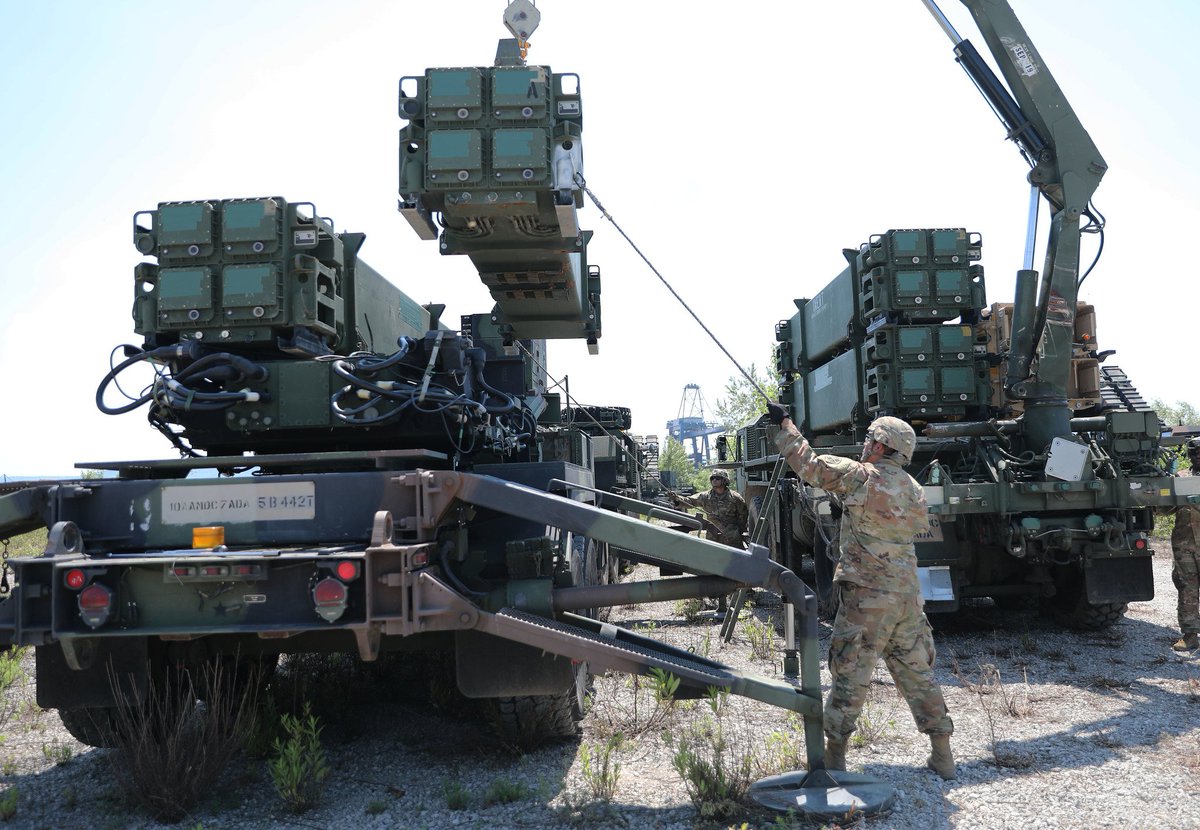The subject of this thread is "Commercial Open Source Military Radar Detection in Semi Real Time" courtesy of Bellingcat.
1/
bellingcat.com/resources/2022…
1/
bellingcat.com/resources/2022…
This is text from the beginning of the previous link:
The Radar Interference Tracker (RIT) is a new tool created by Ollie Ballinger that allows anyone to search for and potentially locate active military radar systems anywhere on earth.
Image- Sentinel-1 interference pattern
2/
The Radar Interference Tracker (RIT) is a new tool created by Ollie Ballinger that allows anyone to search for and potentially locate active military radar systems anywhere on earth.
Image- Sentinel-1 interference pattern
2/

It turns out that the Sentinal-1 commercial synthetic aperture radar (SAR) signal frequency is interfered with by C-band radars like those used by Patriot, S-300P FLAP LID & successors, 5N62 SQUARE PAIR, in fact a good number of Russian acquisition and engagement radars.
3/


3/



Two Sentinal-1 SAR-sat passes and you get an interference pattern "X" that marks the spot of a C-band emitter.
4/

4/


Also via Bellingcat:
Other military radars that operate on the same C-band frequency include naval radars such as the Japanese FCS-3, the Chinese Type-381 and the Russian S-400 surface-to-air missile system. All should be detectable when switched on and in view of Sentinel-1.
5/


Other military radars that operate on the same C-band frequency include naval radars such as the Japanese FCS-3, the Chinese Type-381 and the Russian S-400 surface-to-air missile system. All should be detectable when switched on and in view of Sentinel-1.
5/



The ability of non-state actors UAV's to play SEAD games by going after Patriot C-band emitters with this tool is also a threat not to be underestimated.
6/
6/
https://twitter.com/ELINTNews/status/1474890453455712265
There are two responses to this radar interference tool tracking, one operational and one technological.
The operational one needs WW2 style close range anti-drone defense of primary ADA like the 50 cal Maxon turret was shielding 40mm & 90 mm HAA from strafing fighters.
7/

The operational one needs WW2 style close range anti-drone defense of primary ADA like the 50 cal Maxon turret was shielding 40mm & 90 mm HAA from strafing fighters.
7/


Smart and/or drone combat experienced SAM operators have already are already doing this. Facebook posts show Ukrainians attaching DShKM and ZU-23-2 sections to S-300 and Buk M1 batteries.
8/
8/

The other response is technological.
Putting on my 'old crow' cap, C-band ADA radars need to shift to using lower power wideband frequency hopping to push the peak power below the interference threshold of the satellites.
9/
Putting on my 'old crow' cap, C-band ADA radars need to shift to using lower power wideband frequency hopping to push the peak power below the interference threshold of the satellites.
9/

The problem with that tech solution is higher radiated power is absolutely required for C-band radar anti-ballistic missile role.
This is why the operational combined arms solution will be used more often, but the tech solution still has to happen.
10/
This is why the operational combined arms solution will be used more often, but the tech solution still has to happen.
10/

The issue of radar interference allowing your opponents geolocate your emitters is as old as radar.
The Allies chose UK Mark III Identification Friend or Foe over the USN's Mark IV because the latter interfered with German radars. It was true when the decision was made.
11/


The Allies chose UK Mark III Identification Friend or Foe over the USN's Mark IV because the latter interfered with German radars. It was true when the decision was made.
11/



Unfortunately, this non-interference did not stay so for long.
When the RAF Bomber Command used its Mandrel jammers.
The Germans moved their Freya radar to higher frequencies that the Mark III IFF responded too.
12/

When the RAF Bomber Command used its Mandrel jammers.
The Germans moved their Freya radar to higher frequencies that the Mark III IFF responded too.
12/


Per "British Intelligence in the Second World War" Volume 3, Part 1, the Luftwaffe exploited this radar interference such that it may have been the primary reason Bomber Command lost the Battle of Berlin during the Winter/spring of 1943-1944.
13/
13/

Further on Jones wrote:
"...the Germans’ own (Enigma) reports 9 out of the 41 aircraft lost on 2nd/3rd December against Berlin had been shot down because of their use of I.F.F., 4 out of 24 lost on Leipzig on the following night and 6 out of 26 on Berlin on 16/17th December—
15/
"...the Germans’ own (Enigma) reports 9 out of the 41 aircraft lost on 2nd/3rd December against Berlin had been shot down because of their use of I.F.F., 4 out of 24 lost on Leipzig on the following night and 6 out of 26 on Berlin on 16/17th December—
15/
and these may have been due to one plotting station alone."
Similar tracking of US planes and ships was happening during the Kamikaze campaign in the Pacific because Japanese aerial radars also addressed the Mark III IFF.
16/


Similar tracking of US planes and ships was happening during the Kamikaze campaign in the Pacific because Japanese aerial radars also addressed the Mark III IFF.
16/



Radar interference, as a tool to track enemy radars, is as old as radars.
But it's history lessons are seldom, if ever, taught. This is why 'Old Crows' say:
"It's what you think you know.
That isn't so.
Which kills you every time."
17/End
But it's history lessons are seldom, if ever, taught. This is why 'Old Crows' say:
"It's what you think you know.
That isn't so.
Which kills you every time."
17/End

@threadreaderapp please unroll
• • •
Missing some Tweet in this thread? You can try to
force a refresh









